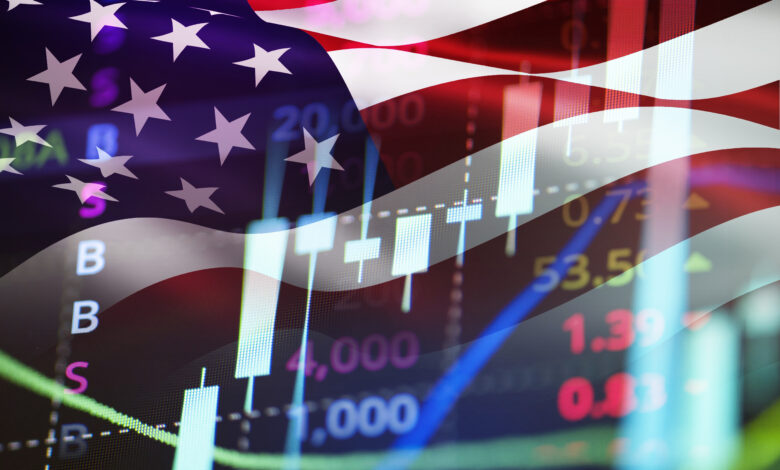U.S Stock

The U.S Stock Market is one of most influential and dynamic financial markets in the entire world. It is a barometer of the American economy, and it plays a vital role in global finance. The U.S. Stock Market offers investors many opportunities to increase their wealth. Understanding the complexities of the market is important for those who want to make an informed investment decision. The U.S. Stock Market is made up of several major exchanges. The NYSE is located on Wall Street and is home to some of the most well-established companies. The NASDAQ, on the other hand, is known for its technology listings. This includes giants such as Apple, Microsoft, Amazon, and others. These exchanges offer a place for investors to buy and sell shares in publicly traded companies.
Table of Contents
Introduction: Understanding the U.S Stock Market
The U.S Stock Market is the cornerstone of global financial markets, providing investors with opportunities to increase their wealth through buying and selling publicly traded shares. To navigate this complex market successfully, you must first understand its structure, its key components and the factors driving its performance. This introduction is intended to give a basic understanding of the U.S Stock Market, allowing for a more in-depth exploration in the subsequent sections.
What is the Stock Market ?
Stock market is the place where shares are traded. Investors purchase and sell shares in the hope of making a profit from the performance of the company. The U.S. Stock Market is the largest and liquidest in the world. It’s a vital venue for raising capital, and it helps to foster economic growth.
The Importance Of The U.S Stock Market
The U.S. Stock Market is more than just a reflection on the American economy. It is also an important player in the global finance system. The U.S stock market influences global economic policies and investor sentiment, while providing companies with the capital they need to expand. The U.S. Stock Market offers many investment options for individual investors. These range from blue-chip companies with a long track record to high-growth tech firms.
What is the U.S stock market?
The U.S Stock Market is based on stock exchanges where companies can list their shares and investors trade them. Stock prices fluctuate due to supply and demand. These factors include company performance, economic indicators and investor sentiment. The stock market is regulated in order to maintain transparency, fairness and protect investors against fraud.
Why Invest in U.S Stock Markets?
The U.S Stock Market offers the potential of significant returns over time, particularly for long-term investors. Market performance is consistent, which makes it a good option for individual investors and institutions. The U.S. Stock Market offers a wide range of investment opportunities that allow investors to customize their portfolios according to their financial goals and tolerance for risk.
The U.S Stock Market Structure
The U.S Stock Market is a multifaceted and complex system that includes various exchanges and market participants as well as regulatory bodies. Investors who want to navigate the stock market successfully must understand its structure. This section examines the main components of the U.S Stock Market, including the role of the major stock markets, the process for listing and trading and the importance of market indices.
Major U.S Stock Exchanges
The U.S Stock Market is mainly organized around two major exchanges, the New York Stock Exchange and the NASDAQ. These exchanges are platforms where investors and companies can trade shares.
- New York Stock Exchange: Located on Wall Street, New York City’s largest and oldest exchange is the NYSE. The NYSE is well-known for its listing of many of the most valuable and established companies in the world, such as those involved in consumer goods, finance, and energy. The NYSE uses an auction system, where human brokers and electronic systems facilitate transactions.
- NASDAQ Unlike the NYSE, NASDAQ operates entirely electronically and is known for its association to technology companies. Apple, Microsoft and Tesla are among the most innovative and fastest-growing companies in the world. NASDAQ’s automated system allows for rapid trade execution and has a higher volatility than the NYSE.
Trading and Listing Process
Listing a company in the U.S Stock Exchange involves several steps. The first is an Initial Public Offer (IPO). During an IPO a company sells shares for the first to the public, in order to raise capital for expansion and growth. After a company is listed, its shares are traded at the exchange where prices fluctuate according to supply and demand.
Initial public offering (IPO)
A company’s IPO marks its transition from a private entity to a publicly listed one. The IPO involves regulatory approval, setting a price for the shares, and marketing to potential investors.
Trading Mechanisms
The U.S Stock Market is a market where trades are carried out by a network consisting of buyers and vendors. On the NYSE trades are facilitated by brokers in the trading room, whereas NASDAQ is entirely dependent on electronic systems. Trading involves placing orders, matching those orders with opposing orders, and then executing transactions at best-available prices.
Market Indices
The market indices are crucial to the U.S Stock Market, as they provide a snapshot of market performance. These indices provide insights into the market and economic health by tracking selected groups of stocks.
- Dow Jones Industrial Average: DJIA, one of the world’s most famous stock market indices is composed of 30 large publicly-owned companies in various industries. It is used to gauge the health of the U.S. economic system.
- S&P 500 The S&P 500 Index tracks 500 of the biggest publicly traded companies in America. The S&P 500 index is widely considered to be one of the most accurate representations of U.S. stocks, since it includes companies in various industries and sectors.
- NASDAQ Composite The NASDAQ Composite Index includes all stocks listed on NASDAQ, with a strong emphasis on technology firms. It is an important indicator of the tech industry’s performance.
The Key Players on the U.S Stock Market
A diverse group of players shapes the U.S Stock Market, with each participant playing a specific role in its functioning and stability. The key players are institutional investors, retail traders, market makers and regulatory agencies. Anyone who wants to effectively engage in the stock market must understand the roles and influence of these participants.
Institutional Investors
Institutional investors are companies that invest large amounts of money on behalf of other people in the stock exchange. Mutual funds, pension funds and hedge funds are some of the institutions that fall under this category. Insurance companies, endowments, and insurance companies also fit into this category. Institutional investors are able to have a significant impact on the stock market because they manage large amounts of capital.
- Mutual Funds Mutual Funds pool money from individual investors in order to buy a diverse portfolio of stocks or bonds. Mutual funds are managed by professionals who have specific investment goals in mind, such as growth or income. Their large-scale investment can affect stock prices and market trends.
- Retirement Funds: Retirement funds invest in various assets to achieve long-term stability and growth. Pension funds invest in government bonds and stable blue-chip stocks because of their long-term investment outlook. Their constant demand for stocks helps to maintain market stability and liquidity.
- Private Investment Funds: These funds use a variety of strategies to achieve high returns. They often do this through speculative investment. Hedge funds are not regulated like mutual funds and they can use complex strategies such as leverage, short-selling, etc. Their activities can result in significant price changes for the stocks that they target.
Retail Investors
Retail investors are individuals who invest in securities on their own behalf, not for an organization. Retail investors have increased significantly in recent years on the U.S. Stock Market, largely due to the growth of mobile apps and online trading platforms that make it easier for people to access the stock market.
- Online Trading is on the Rise: Online brokerage platforms such as Robinhood E*TRADE and TD Ameritrade have democratized stock market access. Retail investors are now able to buy and sell ETFs and options for minimal fees, with no minimum account. The market has seen a rise in participation, particularly among young investors.
- Influence of Market Volatility Although retail investors have smaller portfolios, their collective action can have an important impact on the market volatility. This was apparent during events such as the GameStop Short Squeeze, when coordinated buying by retail traders led to dramatic price changes.
Market Makers
Market makers are individuals or financial institutions that continuously buy and sell securities to provide liquidity on the stock exchange. Market makers play an important role in stabilizing prices and facilitating smooth trading by ensuring there is always a stock market.
- How Marketmakers Operate: The market makers quote a buy and sell price for an individual stock. They profit from the difference between these two prices. They are ready to buy and sell when other people want to do so, and ensure that trades are executed quickly. This activity is crucial for maintaining the market’s liquidity, particularly in stocks that are not actively traded.
- Market makers’ role in price stabilization: By supplying liquidity, they help to reduce fluctuations in prices and ensure that the stock prices reflect current market information. They are especially important in times of high market volatility or stress, because they maintain order on the markets and prevent price fluctuations.
Regulatory Bodies
The U.S Stock Market is regulated by regulatory bodies to ensure transparency, fairness and investor protection. These organizations set rules and regulations to govern market activity and enforce compliance by market participants.
- Securities and Exchange Commission: SEC is the main regulatory authority of the U.S. Stock Market. The SEC is responsible for the enforcement of federal securities laws, regulation of the securities industry and protection of investors. The SEC makes sure that investors receive accurate information in a timely manner and that all market participants follow fair trading practices.
- Financial Industry Regulatory Authority: FINRA oversees exchange markets and brokerage firms. It protects investors by ensuring brokers adhere to industry standards and operate with integrity. FINRA provides investors with educational resources that help them make informed decisions.
- Federal Reserve Although not directly controlling the stock market, Federal Reserve’s monetary policy decisions influence market conditions. The Federal Reserve, by setting interest rates and controlling money supply, can influence investor behavior, borrowing cost, and overall liquidity of the market.
Blue-Chip Growth Stocks, Value Stocks, and Growth Stocks
Investors have many options on the U.S. Stock Market. Each stock has its own return and risk profile. Blue-chip stocks are often discussed, as well as growth stocks and value stocks. Investors can make better decisions if they understand the characteristics of these types.
Blue-Chip Stocks
Blue-chip shares are those of well-established and financially stable companies that have a track record of reliable performance. These companies are usually leaders in their respective industries, known for their stability and strong balance sheets. They are also able to weather economic downturns.
- Blue-Chip Stocks Characteristics: The blue-chip stock is often associated with household brands such as Apple, Microsoft and Johnson & Johnson. These companies are known for their steady earnings growth and pay out regular dividends. Blue-chip stocks, because of their stability and long-term growth, are considered to be safer investments.
- Benefits to Investing in Blue Chip Stocks: Investors choose blue chip stocks for their consistency and reliability. These stocks have a lower volatility than smaller, less established firms, which makes them an excellent choice for conservative investors and those who are nearing retirement. Dividends from blue-chip companies are a good source of income.
- Blue-Chip Stocks Risks: Although blue-chip stocks tend to be low-risk in general, they do not come without risks. These companies may have a limited growth potential compared to smaller firms because they are large and well-established. They can also be affected by economic downturns, but they recover faster than smaller companies.
Growth Stocks
Growth stocks are companies expected to grow faster than the average compared to their peers in the market. They reinvest the earnings rather than pay dividends. This is done to increase their market share and profitability, as well as expand their business.
- Characteristics Growth Stocks: The industries that have the highest potential for expansion and innovation, like technology, biotechnology and renewable energy, are where you will find growth stocks. Amazon, Tesla and Google are all prime examples of companies that have growth stocks. These companies are characterized by rapid growth, and high P/E ratios that reflect investor optimism.
- Benefits to Investing in Stocks for Growth: The main attraction of stocks for growth is the potential capital appreciation. Growth stock investors are seeking significant returns, as their companies grow and their stocks increase. Growth stocks are attractive to investors who have a high risk tolerance and long-term investment horizon.
- Risks associated with growth stocks: Stock prices of growth stocks are highly volatile and can fluctuate wildly based on the market sentiment or company performance. These companies do not usually pay dividends so investors are reliant on capital gains. Stock prices can fall sharply if a company’s growth fails to meet expectations. This could lead to substantial losses.
Value Stocks
Value stocks are companies whose shares are undervalued in the market. Value stocks are typically traded at lower P/E and P/B ratios than their peers. This suggests that investors may be overlooking or undervaluing them.
- Characteristics Of Value Stocks: A value stock is a stable company with a steady earnings record, which may temporarily be out of favor because of short-term market challenges or other factors. Value stocks can include companies from traditional industries such as manufacturing, finance or utilities. Value stocks are often seen as bargains with the potential to appreciate in price as the market adjusts its valuation.
- Benefits to Investing in Value Shares: Investors choose value shares because they can offer strong returns, if the stock market recognizes the true worth of the company. Dividends are often paid by value stocks, which provides an extra income stream to investors. Value investing is also based on the idea of buying low and then selling high. This can result in significant gains.
- Value Stocks Risks: Although value stocks can offer a substantial upside, there are also risks. Markets may take a long time to realize the value of these shares, resulting in prolonged periods of underperformance. Some value stocks are undervalued due to valid reasons such as declining industries, or fundamental weaknesses within the company. To avoid value traps, it is important to carefully analyze value stocks before investing.
Factors influencing the U.S stock market
Stock prices in the U.S can be affected by many factors. Investors must understand these factors, because they affect market sentiment, investor behaviour, and the value of investment. Economic indicators, corporate earnings and interest rates are all key factors that affect the U.S Stock Market.
Economic Indicators
Economic indicators are statistical measures which reflect the health and direction of an economy. These indicators can provide important insights into the economy and have a significant impact on stock market trends.
- Gross domestic product (GDP). The GDP is an important economic indicator, indicating the value of all goods and services produced by a nation over a certain period. A rising GDP can indicate a strong economy and boost investor confidence, leading to higher stock prices. A declining GDP can indicate economic problems, which could lead to lower stock values.
- Unemployment rate: This measure measures the percentage in the labor force who are unemployed, but are actively looking for work. A low rate of unemployment indicates a healthy labor market. This can have a positive impact on consumer spending, corporate profits and stock prices. A high rate of unemployment, on the contrary, can lead to lower consumer spending and corporate earnings. This will negatively affect stock prices.
- Rate of Inflation: The rate at which the prices of goods and services increase over time is measured by inflation. Moderate inflation, however, is often a sign that the economy is growing. High inflation, on the other hand, can lead to lower purchasing power, higher interest rates and a negative impact on stock markets. A fall in prices can be detrimental, and may indicate economic weakness.
- Consumer Confidence Index: CCI measures consumers’ optimism or pessimism about the future of the economy. A high level of consumer confidence can lead to higher spending and stock prices. Low consumer confidence can lead to reduced spending and lower stock values.
Corporate Earnings
Corporate earnings are the profits generated by companies from their business operations. These earnings are the main driver of stock price, since they reflect a company’s financial health and performance.
- Earnings reports: Companies must report their earnings on a quarterly basis. These reports provide information on revenue, earnings per share, and net income. Stock prices often rise when earnings reports are strong, because they show that the company is doing well. In the opposite case, disappointing earnings may lead to a drop in stock price.
- Earnings guidance: Companies often report past earnings and provide earnings guidance. This is their projection of future performance. Positive guidance can increase investor confidence, which can drive up stock prices. Negative guidance can cause stock prices to fall.
- Earnings Surprises: A surprise in earnings occurs when earnings are higher or lower than expected by analysts. Positive earnings surprises may lead to a sharp increase in stock prices. Negative surprises could cause stock prices drop.
Interest Rates
The Federal Reserve’s interest rates have a major impact on the U.S. Stock Market. Interest rate changes can impact the cost of borrowing and consumer spending. They can also affect overall economic activity.
- Federal Reserve Interest Rates The Federal Reserve controls the federal fund rate, the rate of interest at which banks lend each other overnight. The Fed increases interest rates which in turn can lead to a reduction in consumer spending and investment. This can result in lower corporate earnings, and a drop in stock prices. In the opposite direction, when interest rates are lowered by the Fed, borrowing is cheaper. This can encourage spending and investment which will drive stock prices up.
- Impact of Different Sectors: Changes in interest rates can have a variety of effects on different sectors. Higher interest rates can negatively affect interest-sensitive industries like real estate or utilities because they increase borrowing costs. Higher interest rates may be beneficial to financial stocks, since banks are able to charge higher loan fees.
- Bond market relationship: The bond market is also affected by interest rates, and competes with the stock markets for investor’s money. Bond yields rise when interest rates increase, making them more attractive than stocks. This can cause a shift of investment from stocks to bond, which puts downward pressure on the stock price.
Geopolitical Events
Geopolitical events are developments in international relations and conflicts that can have a far-reaching effect on the global stock market and economy.
- Conflicts and Wars: Warfare and military conflicts are often disruptive to economic activity, and can lead to increased defense spending. Investors can become more risk-averse and sell stocks in favor of safer assets such as gold or government bonds. The stock market’s impact can be different depending on how large and where the conflict is.
- Tariffs and Trade Policies: Changes to trade policies such as tariffs and trade restrictions can affect global supply chains, and the profitability of businesses that depend on international trade. A trade war between the U.S.A. and China, for example, can cause market volatility and uncertainty as companies face increased costs and reduced access.
- Political Changes and Elections: Elections can have a significant impact on the stock market, especially in large economies such as the United States. Investor sentiment can be affected by the outcome of an electoral, depending on how investors perceive the impact of the new government’s policies on business and the economy. Market volatility can be caused by political instability or a change in leadership.
- Global Health Crises Global Health crises such as the COVID-19 Pandemic can have a serious impact on the stock markets. These events can cause disruptions in the economy, leading to business closures and uncertainty. This could lead to significant stock market declines.
Investment Strategies for the U.S Stock Market
The U.S Stock Market offers a wide range of investment strategies to suit different risk appetites and goals. Understanding these strategies will help investors to make better decisions and maximize their returns. The buy-and hold strategy, swing trading, day trading, and diversification are among the most popular strategies.
Buy and Hold Strategy
Buy-and-hold is a strategy for long-term investing where investors buy stocks and hold them for a prolonged period of time, regardless market fluctuations. This strategy is based upon the belief that the stock market’s value will increase over time. It could also lead to dividend income and capital appreciation.
- How it Works: Investors who use the buy-and hold strategy select stocks from companies that have strong fundamentals, stable earning, and growth potential. These stocks are purchased with the intent of holding on to them for many years or even decades. This allows the investment value to grow over time. This strategy involves patience and discipline as it requires you to ride out the short-term volatility of the market without panicking.
- Benefits of Buy-and Hold: The simplicity of this strategy is one of its main advantages. Investors don’t need to monitor the market constantly or make frequent transactions, which reduces transaction costs and impacts of short-term gains taxes. This strategy also takes advantage of compounding. Dividends and capital gains are reinvested to generate more earnings over time. This strategy is appealing to long-term investors because the U.S. Stock Market has historically shown a positive trend.
- Buy-and Hold: Although the buy-and hold strategy is considered to be low-risk in general, it does not come without challenges. During periods of market declines, the value of an investor’s holdings can fall. This requires both a firm belief in the long-term potential of the market and the ability for investors to tolerate temporary losses. The wrong stocks may also lead to underperformance, or even loss over time, if companies do not grow as expected.
Day Trading & Swing Trading
Swing trading and day trading are short-term investments that require buying and selling stocks in a short period of time to take advantage of market fluctuations. These strategies require active market management, technical analysis and a thorough understanding of the dynamics.
- day trading is the act of buying and selling shares within the same trading session, in order to profit from small price fluctuations. Day traders use charts, technical analysis and real-time data to identify quick gains. This strategy is highly complex, since traders must make quick decisions and quickly execute trades. Day trading is highly profitable, but also risky. Market volatility can cause substantial losses if the trades don’t go according to plan.
- SWING TRADING: In contrast, swing trading involves holding stocks over a period of days or weeks in order to profit from short- and medium-term trends. Swing traders are interested in stocks that will move dramatically over the next few days due to economic data, earnings reports or technical indicators. Swing trading is less stressful than day trading because it allows more flexibility and less trading. To maximize profits, swing trading still requires careful timing and analysis.
- Day Trading and Swing Trading Advantages: These trading strategies can provide quick profits as traders can take advantage of short-term market fluctuations. These strategies also offer the chance to profit from both rising and declining markets using techniques like short selling. Day trading and swing trading are lucrative for those who have the skills and tolerance to risk.
- Day Trading and Swing Trading Risks: These strategies are prone to high volatility and unpredictability in the short-term. The market conditions can quickly change, resulting in unexpected losses. Day trading is also associated with high transaction costs, short-term capital gains tax, and frequent buying and sales, all of which can reduce profits. These strategies require traders to be emotionally resilient and have a large time commitment.
Diversification
Diversification involves spreading your investments over a wide range of assets in order to reduce the risk. A diversified portfolio can help protect investors from large losses in the event that a stock or asset class does poorly.
- How it Works: The process of diversification involves investing a mixture of stocks, bonds and other assets in different industries, sectors and geographical regions. An investor may hold bonds, real estate, and stocks in the technology, healthcare and consumer goods industries. Different assets will react differently to market changes, so if one investment does poorly, other investments may do well. This helps balance the overall risk.
- Benefits of Diversification The main benefit of diversification comes from reducing risk. Investors can reduce the negative impact of an investment that does not perform well by not placing all their eggs into one basket. Diversification allows investors to take part in various areas of the markets, potentially capturing multiple gains. A diversified portfolio will provide more stable returns over the long-term than a portfolio that is concentrated.
- Diversification Risks: Diversification can reduce risk but also limit returns. When certain assets or sectors are performing well, a portfolio that is highly diversified may not perform as well. This is because the gains of the top performers are offset by the losses from other assets. Over-diversification may also lead to a portfolio that is too spread out to see meaningful growth. To maximize their returns, investors need to find the right balance between concentration and diversification.
Conclusion: the Future of the U.S Stock Market
The U.S Stock Market has been a cornerstone in the global financial system for many years, reflecting the strength and growth of American economy. Investors will face both challenges and opportunities as we look towards the future. Anyone looking to navigate through the complexity of the market over the next few years will need to understand these factors.
Technological Innovation IN U.S Stock
The stock market in the United States will continue to be driven by technological advancements. As new technologies disrupt and transform traditional industries, sectors like biotechnology, fintech, artificial intelligence and renewable energy are expected to grow significantly. Stock prices of companies at the forefront will rise substantially, making technology an important area for future investment. The rapid pace of change can also bring volatility as new market entrants can overtake the leaders.
Economic Growth and Monetary Policy
The performance of the U.S Stock market in the future will be closely linked to the health of the economy. The market will most likely move upwards if the economy continues to grow, thanks to strong consumer spending and business investment. The Federal Reserve’s monetary policy, and in particular its interest rate decisions, will play a crucial role. Interest rate changes can have a significant impact on the market, affecting both investor behavior and corporate earnings. Investors must closely monitor these factors to predict market movements.
Globalization of Geopolitical Events OF U.S Stock
The future of the U.S Stock Market will be shaped by globalization. Globalization is interconnected, so events happening in other countries, like trade agreements, geopolitical tensions or economic crises can have an immediate impact on U.S stock prices. Market volatility could be increased by, for example, disruptions in supply chains, changes in trading policies or conflicts in certain regions. Positive developments in global cooperation and trade could also create new opportunities for U.S. investors and companies.
Environmental Considerations OF U.S. Stock
Investors are increasingly focusing on environmental, social and governance factors (ESG). These will probably shape the future of U.S stocks. Investors are paying more attention to companies that place a high priority on sustainability, ethical practices and social responsibility. Companies that do not address climate change or social issues may see their stock prices and investor interest decline as awareness grows. Companies that are leading the way in ESG initiatives can see improved market performance and increased investor loyalty.
Investor Behavior and Market Volatility
The volatility of the market is a part of investing on the stock exchange, and is expected to continue into the future. Volatility can be exacerbated by economic cycles, technological disruptions and geopolitical issues. Understanding investor psychology and the market’s sentiment is crucial to navigating through these fluctuations. Investors who are disciplined, have a long-term outlook, and stick to sound investing strategies will be more successful in times of volatility.
Regulation OF U.S. Stock
The future of the U.S Stock Market will be affected by regulatory changes. Regulations governing financial markets will also evolve as the market changes. The market landscape will be shaped by issues such as cybersecurity, data privacy and regulation of new technologies, like cryptocurrencies. Changes in corporate governance or tax policies could also influence the market’s behavior and investment decision. Investors must stay abreast of regulatory changes and adapt their strategies.




